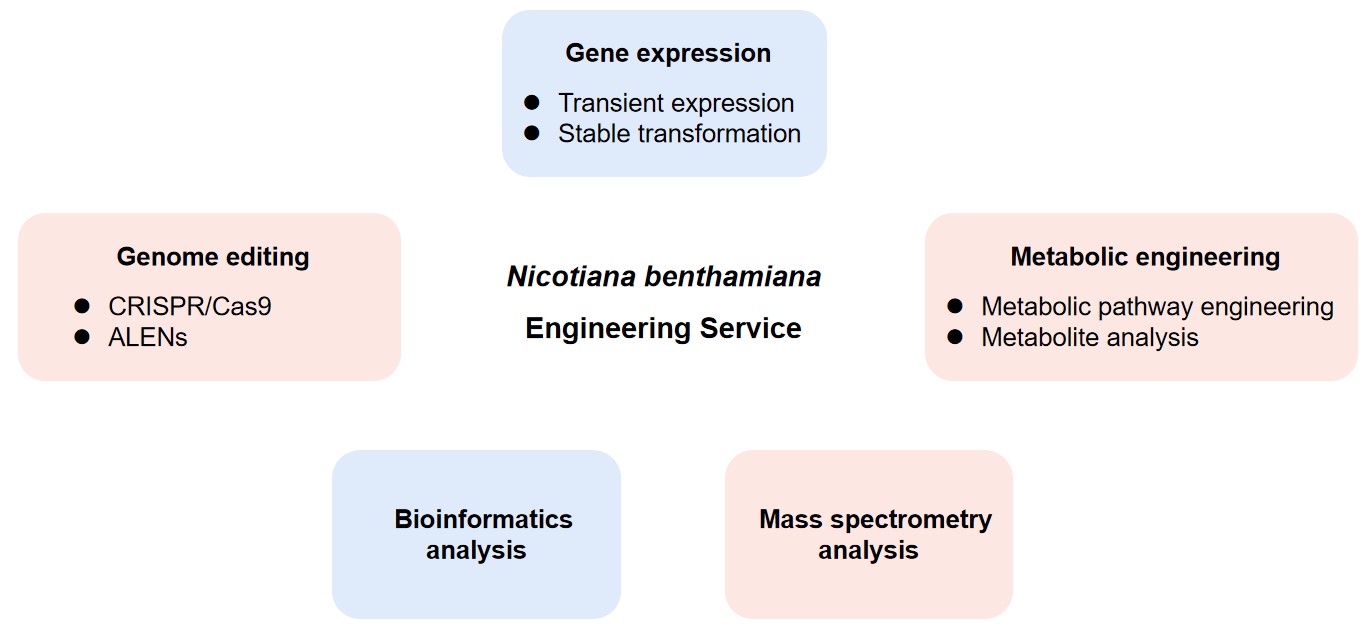Nicotiana benthamiana Engineering Service
Nicotiana benthamiana serves as an important model plant in the field of synthetic biology. Through engineering transformation, it is widely used in the production of glycosylation products, the regulation of glycan signaling pathways, the optimization of glycan metabolism pathways, and the study of interactions between plants and microorganisms. N. benthamiana engineering involves the use of this particular type of tobacco leaf as a framework for engineering complex glycans inside living cells. Synthetic glycobiology aims to understand and manipulate the biological processes involved in the synthesis and function of glycans.
Nicotiana benthamiana Engineering Service at CD BioGlyco
At CD BioGlyco, N. benthamiana is one of the many Plant Chassis for synthetic biology we provide. With the advanced GlycoChas™ Cells platform, we offer comprehensive N. benthamiana engineering service.
 Fig.1 N. benthamiana engineering service. (CD BioGlyco)
Fig.1 N. benthamiana engineering service. (CD BioGlyco)
Genome editing
Genome editing technologies, particularly the CRISPR/Cas9 system, are critical for engineering N. benthamiana. The CRISPR/Cas9 system allows researchers to modify glycosylation pathways in plants by inserting or deleting specific genes to produce the desired glycans.
Gene expression
Transient expression: Foreign genes can be quickly expressed in N. benthamiana leaves through Agrobacterium-mediated transient transformation. This technique is commonly used to verify the function and activity of glycosyltransferases and to produce glycosylation products.
Stable transformation: Through Agrobacterium-mediated stable transformation, foreign genes can be integrated into the genome of N. benthamiana to achieve long-term and stable expression of foreign genes. This has important implications for the construction of transgenic plants with specific glycosylation capabilities.
Metabolic engineering
By regulating the glycan metabolism pathway in N. benthamiana, the production of specific glycans can be increased or the composition of glycans can be changed. This can be achieved through gene overexpression, gene silencing, or the introduction of exogenous enzymes.
Bioinformatics analysis
Through high-throughput sequencing technology, the genome and transcriptome of N. benthamiana can be analyzed to identify genes and transcripts related to glycobiology, providing basic data for subsequent gene editing and metabolic engineering.
Mass spectrometry (MS) analysis
MS is a powerful analytical technique used to identify and quantify glycans produced in N. benthamiana. This technique is critical for confirming the structure of engineered glycans.
Publication
Technology: N-glycan engineering
Journal: Frontiers in Plant Science
IF: 6.627
Published: 2023
Results: The authors used N-glycan engineering to fine-tune the production of recombinant antibodies in plant platforms. They co-expressed IgG with murine β1,4-galactosyltransferase (β1,4-GALT) to modify plant N-glycan with β1,4-linked Gal residue(s), and with β1,3-galactosyltransferase (β1,3-GALT) to augment galactosylation. The authors were successful in modifying the N-glycan structures on the plant-derived IgG through the IgG's co-expression with each GALT. When they carried out an analysis on the N-glycan profile of IgG that was co-expressed with β1,3-GALT, the authors observed an upsurge in galactosylation efficiency and an enhanced development of the Lewis structure in plant-based antibodies.
 Fig.2 Transient production of Varlilumab in N. benthamiana. (Nguyen, et al., 2023)
Fig.2 Transient production of Varlilumab in N. benthamiana. (Nguyen, et al., 2023)
Applications of N. benthamiana Engineering
- Glycosyltransferases can be introduced or optimized in N. benthamiana through gene editing and expression technologies. These enzymes catalyze glycosylation reactions between glycan molecules and other compounds. This technique can be used to synthesize complex glycosides.
- N. benthamiana engineering can be used to study the regulatory mechanism of glycan signaling pathways. Through gene editing or gene silencing technology, specific glycan signaling molecules can be interfered with or enhanced to explore how glycan molecules affect biological processes such as plant growth and development, metabolism, and stress response.
- Engineering the glycan metabolic pathway of N. benthamiana can be used to optimize glycan production and utilization efficiency.
CD BioGlyco provides professional N. benthamiana engineering services. Our services include gene editing, gene expression, metabolic engineering, bioinformatics analysis, and MS analysis. We have a professional team to ensure the successful execution of the project. Please feel free to contact us if you are interested in our N. benthamiana engineering service.
Reference
- Nguyen, K.D.; et al. Production and N-glycan engineering of Varlilumab in Nicotiana benthamiana. Frontiers in Plant Science. 2023, 14.
For research use only. Not intended for any clinical use.
Quick Links
Related Services


 Fig.1 N. benthamiana engineering service. (CD BioGlyco)
Fig.1 N. benthamiana engineering service. (CD BioGlyco) Fig.2 Transient production of Varlilumab in N. benthamiana. (Nguyen, et al., 2023)
Fig.2 Transient production of Varlilumab in N. benthamiana. (Nguyen, et al., 2023)


